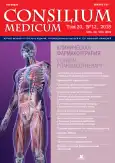Hepatic encephalopathy, diagnostics, differential diagnostics and therapy with ornithine
- Authors: Maksimova E.V1, Kliaritskaia I.L1
-
Affiliations:
- S.I.Georgievsky Medical Academy of the V.I.Vernadsky Crimean Federal University
- Issue: Vol 20, No 12 (2018)
- Pages: 110-116
- Section: Articles
- URL: https://journals.rcsi.science/2075-1753/article/view/95148
- DOI: https://doi.org/10.26442/20751753.2018.12.000019
- ID: 95148
Cite item
Full Text
Abstract
Full Text
##article.viewOnOriginalSite##About the authors
E. V Maksimova
S.I.Georgievsky Medical Academy of the V.I.Vernadsky Crimean Federal University
Email: HelenMaksimovatt@mail.ru
канд. мед. наук, ассистент каф. терапии, гастроэнтерологии, кардиологии и общей врачебной практики (семейной медицины) фак-та подготовки медицинских кадров высшей квалификации и дополнительного профессионального образования МА им. С.И.Георгиевского 295006, Россия, Симферополь, б-р Ленина, д. 5/7
I. L Kliaritskaia
S.I.Georgievsky Medical Academy of the V.I.Vernadsky Crimean Federal Universityд-р мед. наук, проф., зав. каф. терапии, гастроэнтерологии, кардиологии и общей врачебной практики (семейной медицины) фак-та подготовки медицинских кадров высшей квалификации и дополнительного профессионального образования МА 295006, Россия, Симферополь, б-р Ленина, д. 5/7
References
- Lockwood A.H. Hepatic Encephalopathy. Neurology and General Medicine. Fourth ed. Ed. by M.J.Aminoff. Ch. 14. Philadelphia, 2008; р. 265-79.
- Павлов Ч.С., Дамулин И.В., Ивашкин В.Т. Печеночная энцефалопатия: патогенез, клиника, диагностика, терапия. РЖГГК. 2016; 1: 44-53.
- Hepatic Encephalopathy in Chronic Liver Disease: 2014 Practice Guideline by the European Association for the Study of the Liver and the American Association for the Study of Liver Diseases. J Hepatol 2014.
- Кляритская И.Л., Максимова Е.В., Григоренко Е.И. Печеночная энцефалопатия при хронических заболеваниях печени: клинические практические рекомендации (часть I). Крымский терапевт. журн. 2015; 4 (27): 28-35.
- Кляритская И.Л., Максимова Е.В., Стилиди Е.И. Печеночная энцефалопатия при хронических заболеваниях печени: клинические практические рекомендации (часть II). Крымский терапевт. журн. 2016; 1 (28): 28-34.
- Cordoba J. New assessment of hepatic encephalopathy. J Hepatol 2011; 54:1030-40.
- Cordoba J, Ventura-Cots M, Simon-Talero M et al. CANONIC Study Investigators of the EASL-CLIF Consortium. Characteristics, risk factors, and mortality of cirrhotic patients hospitalized for hepatic encephalopathy with and without acute-on-chronic liver failure (ACLF). J Hepatol 2014; 60: 275-81.
- Kaplan P.W, Rossetti A.O. EEG patterns and imaging correlations in encephalopathy: encephalopathy part II. J Clin Neurophysiol 2011; 28: 233-51.
- Кляритская И.Л., Максимова Е.В. Изучение корреляции нового метода диагностики печеночной энцефалопатии (критической частоты мельканий) с клинико-лабораторными методами у онкобольных на химиотерапии. Крымский терапевт. журн. 2010; 1 (2): 148-52.
- Bajaj J.S, Schubert C.M, Heuman D.M et al. Persistence of cognitive impairment after resolution of overt hepatic encephalopathy. Gastroenterology 2010; 138: 2332-40.
- Riggio O, Ridola L, Pasquale C et al. Evidence of persistent cognitive impairment after resolution of overt hepatic encephalopathy. Clin Gastroenterol Hepatol 2011; 9: 181-3.
- Ferenci P, Lockwood A, Mullen K et al. Hepatic encephalopathy - definition, nomenclature, diagnosis, and quantification: final report of the working party at the 11th World Congresses of Gastroenterology, Vienna, 1998. Hepatology 2002; 35: 716-21.
- Amodio P, Montagnese S, Gatta A, Morgan M.Y. Characteristics of minimal hepatic encephalopathy. Metab Brain Dis 2004; 19: 253-67.
- Montagnese S, De Pitta C, De Rui M et al. Sleep-wake abnormalities in patients with cirrhosis. Hepatology 2014; 59: 705-12.
- Bajaj J.S, Wade J.B, Sanyal A.J. Spectrum of neurocognitive impairment in cirrhosis: implications for the assessment of hepatic encephalopathy. Hepatology 2009; 50: 2014-21.
- Bajaj J.S, Pinkerton S.D, Sanyal A.J, Heuman D.M. Diagnosis and treatment of minimal hepatic encephalopathy to prevent motor vehicle accidents: a cost-effectiveness analysis. Hepatology 2012; 55: 1164-71.
- Lauridsen M.M, Thiele M, Kimer N, Vilstrup H. The continuous reaction times method for diagnosing, grading, and monitoring minimal/covert hepatic encephalopathy. Metab Brain Dis 2013; 28: 231-4.
- Bajaj J.S, Hafeezullah M, Franco J et al. Inhibitory control test for the diagnosis of minimal hepatic encephalopathy. Gastroenterology 2008; 135: 1591-600.
- Bajaj J.S, Cordoba J, Mullen K.D et al. Review article: the design of clinical trials in hepatic encephalopathy - an International Society for Hepatic Encephalopathy and Nitrogen Metabolism (ISHEN) consensus statement. Aliment Pharmacol Ther 2011; 33: 739-47.
- Sharma P, Sharma B.C, Puri V, Sarin S.K. Critical flicker frequency: diagnostic tool for minimal hepatic encephalopathy. J Hepatol 2007; 47: 67-73.
- Bajaj J.S. Management options for minimal hepatic encephalopathy. Expert Rev Gastroenterol Hepatol 2008; 2: 785-90.
- Romero-Gomez M, Cordoba J, Jover R et al. Value of the critical flicker frequency in patients with minimal hepatic encephalopathy. Hepatology 2007; 45: 879-85.
- Lauridsen M.M, Jepsen P, Vilstrup H. Critical flicker frequency and continuous reaction times for the diagnosis of minimal hepatic encephalopathy: a comparative study of 154 patients with liver disease. Metab Brain Dis 2011; 26: 135-9.
- Кляритская И.Л., Максимова Е.В. Поражение печени у пациентов с сахарным диабетом. Крымский терапевт. журн. 2010; 2 (2): 8-13.
- Максимова Е.В. Лекарственные поражения печени у больных раком молочной железы и раком яичников при различных режимах химиотерапии. Крымский терапевт. журн. 2011; 1: 89-92.
Supplementary files






